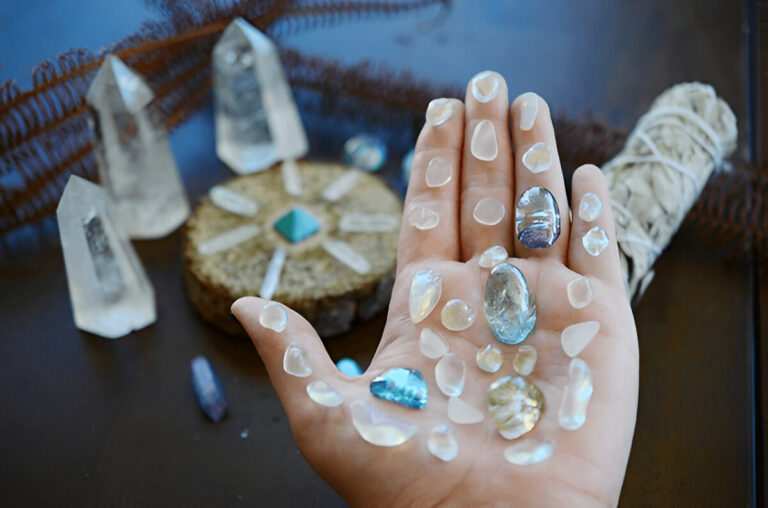“Opal vs Opalite” The debate between natural opal and synthetic opalite has long fascinated jewelry lovers. These stones, each with unique qualities, offer a deep dive into gemology. Whether you’re a seasoned collector or new to gemstones, knowing the difference between opal and opalite is key. It helps you make smart choices and truly appreciate these gems.
Opal, a natural gemstone, is known for its stunning play of color. This display of hues is a result of millions of years of formation deep in the earth. On the other hand, opalite is made in labs, trying to replicate natural opal’s look but with its own special traits.
Key Takeaways
- Opal is a natural gemstone formed over millions of years, while opalite is a man-made synthetic gem.
- Opal is renowned for its unique play of color, whereas opalite is created to mimic the appearance of natural opal.
- Understanding the differences between opal and opalite can help jewelry enthusiasts make informed purchasing decisions.
- Natural opal is a one-of-a-kind creation, reflecting the artistry of nature, while opalite is a product of human craftsmanship.
- Exploring the origins and formation of these two gems provides a captivating glimpse into the world of gemology.
Understanding the Origins and Formation
The world of opals and opalite is fascinating. These gemstones have unique ways of forming. Let’s explore how they come to be.
Natural Opal Formation Process
Opals are known for their stunning colors. They form over millions of years. Silica deposits build up in rock crevices, creating these gems.
This slow process shows nature’s patience and skill. It’s a wonder of the natural world.
Synthetic Creation of Opalite
Opalite, on the other hand, is made by humans. It’s created through opalite manufacturing. Scientists mix silica with other minerals to make it.
This way, they can make opalite that looks like natural opals. It’s a synthetic gem that’s just as beautiful.
Historical Background and Discovery
Opals and opalite have a long history. Ancient people loved them for their beauty and rarity. Today, scientists and gemologists study them.
They explore how to use silica deposits to make these gems. This journey has captured many imaginations over time.
“Opals are not just stones, they are a window into the Earth’s history, a testament to the boundless creativity of nature.”
Opal vs Opalite: Key Differences and Properties
Understanding the difference between natural opal and opalite is key. Both stones have amazing color play, but knowing their differences helps you choose wisely.
Natural opal is a mineral that shines with a rainbow-like effect. This is due to its unique structure that bends light. Opalite, made by humans, looks like opal but doesn’t have this natural magic.
| Feature | Opal | Opalite |
|---|---|---|
| Hardness | 5.5-6.5 on the Mohs scale | 6-7 on the Mohs scale |
| Color Play | Vibrant and iridescent | Limited color play, often dull |
| Durability | Moderate, can be brittle | Relatively durable |
| Value | Highly prized, ranging from affordable to extremely valuable | Generally lower priced than natural opal |
The main differences are in their gemstone characteristics, opal properties, and opalite features. Natural opal’s color play is vibrant and varied. Opalite’s color play is duller. Also, opal is more fragile than opalite.
Natural opal is very valuable, with prices varying based on its beauty and rarity. Opalite is cheaper because it’s made and lacks the natural beauty of opal.
“The play of color in natural opal is a captivating spectacle, unlike anything else in the gemstone world.”
Conclusion
The choice between opal and opalite depends on your personal taste, budget, and how you plan to use it. Both gems are beautiful in their own way. Knowing the differences helps you choose the right one for your needs.
Natural opal is special because of its unique colors and patterns. It’s perfect for those looking for a rare and valuable gem. Opalite, however, is more affordable and easy to find. It has its own charm that suits many jewelry styles.
Choosing between opal and opalite is a personal decision. It’s about what you like, how much you want to spend, and what you’ll use it for. By understanding these gems, you can pick the one that fits your style and goals.
FAQ
What is the difference between opal and opalite?
Opal is a natural gemstone created through a unique geological process. Opalite, on the other hand, is a man-made material that looks like opal. Knowing the origins and properties of these stones helps when buying.
How are natural opals formed?
Natural opals form when silica deposits build up in rock over millions of years. This slow process creates the stunning color play that makes opal so valuable.
What is the process of creating synthetic opalite?
To make opalite, glass or plastic compounds are melted and then cooled. This process allows for a variety of colors and patterns, making it look like natural opal.
What is the history behind opal and opalite?
Opal has been loved for centuries, used by ancient civilizations like the Aztecs and Romans. Opalite, however, is a 20th-century creation, made to be a more affordable option.
How do the properties of opal and opalite differ?
Opal and opalite differ in hardness, durability, color play, and value. Opal is softer and more fragile, while opalite is more durable. Opal’s unique colors are hard to replicate in opalite.
Which stone is the better investment for jewelry and collectibles?
The value of opal and opalite depends on rarity, quality, and personal taste. Natural opal is more valuable, but opalite is cheaper and offers specific colors or designs.
How can I identify the difference between opal and opalite?
Jewelers and gemologists can spot the difference in opal and opalite. They look at appearance, density, and other physical traits. If unsure, it’s wise to ask a professional before buying.


